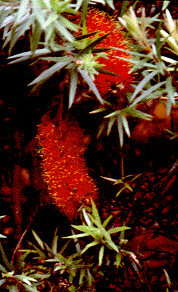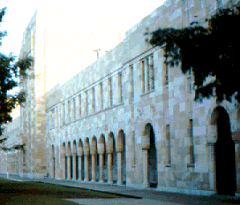 The University of Queensland was established in 1909 by an Act of State
Parliament to commemorate the 50th anniversary of Queensland's separation
from the colony of New South Wales. See
A
Brief History of the University of Queensland.
The University of Queensland was established in 1909 by an Act of State
Parliament to commemorate the 50th anniversary of Queensland's separation
from the colony of New South Wales. See
A
Brief History of the University of Queensland.
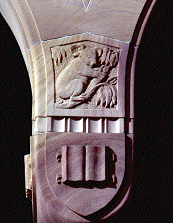
 The University of Queensland was established in 1909 by an Act of State
Parliament to commemorate the 50th anniversary of Queensland's separation
from the colony of New South Wales. See
A
Brief History of the University of Queensland.
The University of Queensland was established in 1909 by an Act of State
Parliament to commemorate the 50th anniversary of Queensland's separation
from the colony of New South Wales. See
A
Brief History of the University of Queensland.
The University's main campus is at St. Lucia which is seven kilometers from
the heart of Brisbane. The campus is 114 hectares and is situated in a
bend of the Brisbane River.
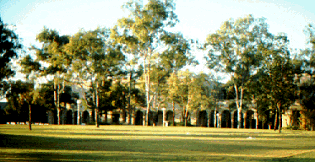 The heart of the campus is a semi-circle of cloistered buildings known
as the Great Court.
The heart of the campus is a semi-circle of cloistered buildings known
as the Great Court.
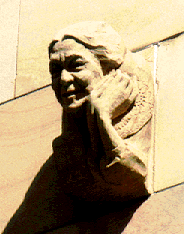 Adorning the buildings are a series of gargoyles based on former faculty.
Adorning the buildings are a series of gargoyles based on former faculty.
 The cloistered walkway provides shade in the heat of the day or
cover in a downpour.
The cloistered walkway provides shade in the heat of the day or
cover in a downpour.
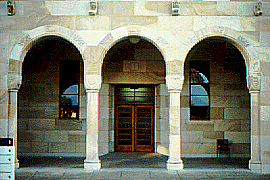 All the buildings on the Great Court are faced with
distinctive Helidon sandstone from a quarry in Queensland.
All the buildings on the Great Court are faced with
distinctive Helidon sandstone from a quarry in Queensland.
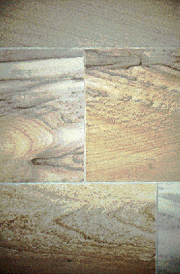 The stone is
a dramatic mixture of hues of brown, tan, grey, salmon, and purple and
is especially beautiful in early morning light.
The stone is
a dramatic mixture of hues of brown, tan, grey, salmon, and purple and
is especially beautiful in early morning light.
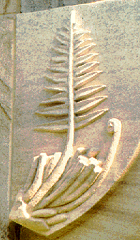
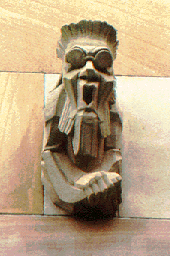 The buildings also
feature carvings of historical figures and scenes...
The buildings also
feature carvings of historical figures and scenes...
...coats of arms, and names of great scholars...
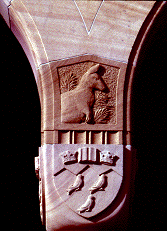
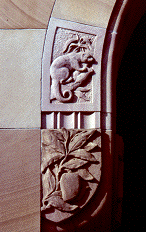 ...and the fauna and flora of Australia.
...and the fauna and flora of Australia.
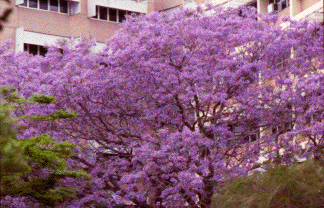 The University of Queensland Library is the largest in the state. Its
central library and 12 branches hold more than 1,600,000 volumes in
addition to periodicals. WWW Interface to
the University of Queensland Libraries.
The University of Queensland Library is the largest in the state. Its
central library and 12 branches hold more than 1,600,000 volumes in
addition to periodicals. WWW Interface to
the University of Queensland Libraries.
Jaccaranda from the UQ campus.
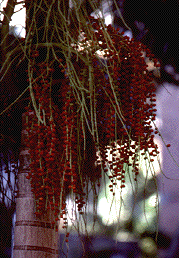
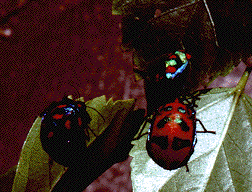
Phylum: Arthropoda Subphylum: Uniramia Class: Hexapoda Order: Hemiptera Species: Tectocoris diophthalmus "Hibiscus Harlequin Bug"These gorgeous insects suck sap from hibiscus plants and their relatives. Females lay clusters of eggs around a twig on the hibiscus and guard them until they hatch.
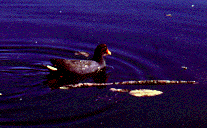
Phylum: Chordata Class: Aves Family: Rallidae Species: Gallinula tenebrosa "Dusky Moorhen"Length: 38--42 cm. Dusky moorhens can be found in freshwater wetlands and ornamental lakes and ponds like the one at the University of Queensland.
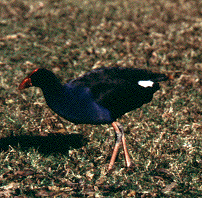
Phylum: Chordata Class: Aves Family: Rallidae Species: Porphyrio porphyrio "Swamphen"Length: 45 cm. Swamphens can be found in swamp margins, lakes, shallow rivers and ornamental lakes. They are widespread from southern Europe to Africa, south and southeast Asia, New Zealand, Fiji, etc.
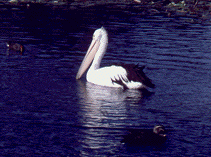
Phylum: Chordata Class: Aves Family: Pelecanidae Species: Pelecanus conspicillatus "Australian Pelican"Length: 1.6 m. Pelicans are common around Brisbane (and Australia generally) in the mudflats near the City Botanic Gardens. Often seen perching on piles or logs. They become tame where fed.
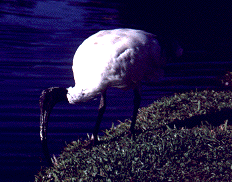
Phylum: Chordata Class: Aves Family: Plataleidae Species: Threskiornis molucca "White ibis"Length: 69--75 cm. The Australian white ibis or sacred ibis is common throughout the eastern half of mainland Australia. It is typically found in pastures, grasslands, or swamps.
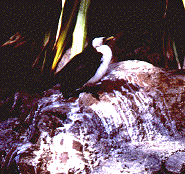
Phylum: Chordata Class: Aves Family: Phalacrocoracidae Species: Phalacrocorax melanoleucos "Little Pied Cormorant"Length 58--63 cm. In Brisbane, cormorants can be found along the Brisbane River or near large reservoirs, creeks, and streams. This photo was taken at the Botanic Gardens at Mt. Coot-tha. It is common throughout Australia and Tasmania.
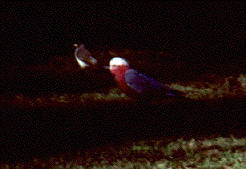
Phylum: Chordata Class: Aves Family: Cacatuidae Species: Cacatua roseicapilla "Galah"Length: 36 cm. Galahs were previously uncommon in the Brisbane area, but can now be seen in pairs or small family groups. There usual habitat includes open woodlands, tree-scattered grasslands, and agricultural areas throughout Australia where they are sometimes considered a pest species.
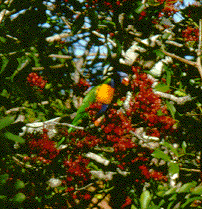
Class: Aves Order: Psittaciformes Species: Trichoglossus haematodus "Rainbow Lorikeet"Length: 28 cm. The colorful Rainbow Lorikeet is widespread in coastal eastern Australia. Often seen in flocks (screeching) just after sunrise or just before sunset. Additional information available on Rainbow Lorikeets.
Class: Mammalia Subclass: Theria Infraclass: Metatheria Species: Thrichosurus vulpecula "Common Brushtail Possum"The common brushtail possum is a medium sized diprotodont with a body length of 500 mm, tail length of 380 mm, and a weight of 4 kg. They are the most commonly encountered Brisbane marsupial. They are nocturnal and are found in either wet or dry forests.
Class: Mammalia Subclass: Theria Infraclass: Methatheria Species: Pseudocheirus peregrinus "Common Ringtail Possum"The common ringtail possum is another medium sized diprotodont with a body length of 350 mm, tail length of 350 mm, and a weight of 4 kg. They are common even in inner city suburbs, parks, along watercourses, and in backyard gardens. They are nocturnal and feed on flowers or leaves.
